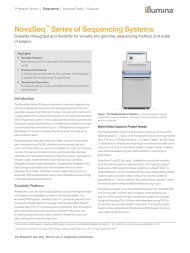Abstracts
ngsfinalprogram
ngsfinalprogram
You also want an ePaper? Increase the reach of your titles
YUMPU automatically turns print PDFs into web optimized ePapers that Google loves.
Poster <strong>Abstracts</strong><br />
bacteria. However, resistance genes are widely<br />
distributed and present in zoonotic agents as<br />
well as commensal bacteria that can exchange<br />
them by horizontal gene transfer. By directly<br />
sequencing animal fecal DNA, the entire intestinal<br />
resistome can be characterized at once.<br />
In this study, we aimed to develop a workflow<br />
appropriate for quantifying agricultural resistance<br />
and use it to characterize the Danish<br />
swine herd resistome. Ten Danish swine herds<br />
with diverse antimicrobial usage were enrolled<br />
in the study. In each herd, a fecal floor<br />
sample was obtained from 30 random pens.<br />
Those random samples were pooled for each<br />
herd and DNA was extracted using a modified<br />
QIAamp stool mini kit protocol. DNA was<br />
fragmented to 300 bp and prepared with the<br />
NEXTflex PCR-Free DNA Library Prep kit.<br />
Libraries were sequenced on a HiSeq2500 (PE,<br />
2x100 bp), producing roughly 7 billion bp/<br />
sample. MGmapper, a BWA-based pipeline<br />
for metagenomics, was used to map qualitytrimmed<br />
reads to the ResFinder database (2130<br />
resistance genes). To ensure high specificity,<br />
we only counted read pairs where both reads<br />
aligned with 50+ bp to the same reference<br />
gene. To minimize unspecific read mapping<br />
without excluding ambiguous alignments, read<br />
counts from gene variants were aggregated to<br />
gene and drug levels. The relationship between<br />
resistance gene abundances and herd-level<br />
antimicrobial consumption of more than seven<br />
drug classes was analyzed using correlation<br />
analysis. A total of 123 resistance genes were<br />
observed and 64 were detected in at least half<br />
of the samples. In all samples, tet(Q), mefA<br />
and tet(W) comprised over half the detected<br />
resistance genes. Besides tetracycline and<br />
macrolide resistance genes, beta-lactam and<br />
lincosamide resistance genes were also very<br />
prevalent. Positive correlations between drug<br />
use and gene abundances were frequently significant<br />
(p < 0.05). This was not the case for<br />
negative correlations, suggesting antimicrobial<br />
use in Danish swine herds is associated with<br />
an increase in resistance gene abundances.<br />
In conclusion, our metagenomic approach<br />
facilitates herd-level resistance monitoring in<br />
swine. The resolution is sufficient to observe<br />
antimicrobial-induced effects on the swine<br />
resistome and quantify more than 100 resistance<br />
genes. The data may furthermore be well<br />
suited to study other functional sequences like<br />
virulence genes and transposable elements,<br />
making metagenomics an attractive option for<br />
routine environmental monitoring.<br />
n 47<br />
MOLECULAR AND GENOMIC TYPING OF<br />
POULTRY ASSOCIATED SALMONELLA<br />
ENTERICA STRAINS FROM NIGERIA<br />
N. Useh 1 , H. Suzuki 2 , N. Akange 1 , M. Thomas 3 ,<br />
A. Foley 3 , M. Keena 3 , E. Nelson 3 , J. Christopher-Hennings<br />
3 , J. Scaria 3 ;<br />
1<br />
University of Agriculture, Makurdi, NIGERIA,<br />
2<br />
Yamguchi University, Yamaguchi, JAPAN,<br />
3<br />
South Dakota State University, Brookings, SD.<br />
Non-typhoidal Salmonellosis is one of the<br />
common cause of bacterial diarrhea worldwide.<br />
Globally 94 million cases of gastroenteritis<br />
and 115,000 deaths each year is estimated<br />
to be caused as a result of non-typhoidal<br />
Salmonellosis. Transmission of pathogenic<br />
Salmonella strains between different countries<br />
has increased due to global travel and food<br />
import. While North America and Europe have<br />
constituted active Salmonella surveillance<br />
programs, very limited epidemiologic data is<br />
available in developing countries, particularly<br />
in sub-Saharan Africa. Therefore, we have<br />
conducted an epidemiologic investigation of<br />
Salmonella prevalence in poultry samples from<br />
Nigeria. Salmonella was isolated by enrichment<br />
culture in tetrathionate broth followed by<br />
growth on XLT4 agar. Identify of the strains<br />
were further confirmed by Matrix Assisted<br />
Laser Desorption Ionization Time-of-Flight<br />
(MALDI-TOF). After positive identification,<br />
virulence of each strain was estimated using<br />
Human Colo-rectal cell (Caco-2) invasion<br />
assay. Total of 40 isolates were typed using<br />
Caco-2 invasion assay. These isolates were further<br />
typed using Next Generation Sequencing<br />
(NGS). Sequencing libraries were prepared us-<br />
ASM Conference on Rapid Next-Generation Sequencing and Bioinformatic<br />
Pipelines for Enhanced Molecular Epidemiologic Investigation of Pathogens<br />
71



